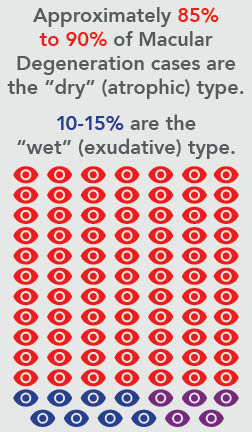What is Macular Degeneration?
Macular degeneration is the gradual breakdown of the macula that occurs with age. The macula is a small area in the back of the eye that allows a person to see fine detail and is responsible for central vision. The breakdown of the macula causes decreased central vision, which can affect our distance and near vision and makes such everyday tasks as facial recognition much more difficult. Many studies have revealed the frequency of this disease increases dramatically after age 60, and there are currently no available cures for the condition.
Types of Macular Degeneration
There are two types of macular degeneration: dry (atrophic) and wet (exudative). Dry macular degeneration is the most common. It is caused by the thinning of the macula as you age. Vision loss is typically gradual. Wet macular degeneration occurs when the blood vessels leak in the back of the eye. Vision loss from this type of macular degeneration is often more rapid and severe.
The wet form is much less common than the dry type and occurs in approximately 10 percent of patients who have the disease. However, wet AMD accounts for 90 percent of the severe visual loss and blindness that is associated with macular degeneration.
 Normal Amsler Grid
Normal Amsler Grid Abnormal Amsler Grid
Abnormal Amsler GridPrevention of Macular Degeneration
Unfortunately, macular degeneration is not wholly preventable, but research by the National Eye Institute has indicated that people at high risk of developing advanced macular degeneration can benefit from a combination of zinc and the antioxidant vitamins C, E and beta-carotene that are available in commercial over-the-counter formulations.
Treatment of Macular Degeneration
Unfortunately, there is no treatment at this time for dry macular degeneration other than the antioxidant vitamin formulations mentioned above to help prevent further loss.
In the wet form of macular degeneration, leaking blood vessels grow abnormally beneath the retina, damaging the macula and distorting the vision. Until recently the only available way to seal these leaking vessels was with a laser or with a treatment known as Photodynamic Therapy.
Photodynamic Therapy (PDT) combines the use of a “cold” laser and treatment with a light sensitive drug. The drug is injected into the vein of a patient’s arm and accumulates in the abnormal blood vessels in the eye. A short exposure to a laser light activates the drug and treats the abnormal vessels. Recent studies involving the Photodynamic drug verteporfin (Visudyne) have demonstrated that at one- and two-year intervals, several treatment sessions limited visual loss for the people involved in the study.
More recently it was discovered that there is a protein in the eye that encourages the development of blood vessels called “vascular endothelial growth factor” (VEGF). There are several drugs called VEGF inhibitors that help prevent the formation of new leaking blood vessels. The two FDA approved drugs are Macugen and Lucentis. Each drug is given as an injection directly into the eye. Both have proven to have similar if not better results in select patients compared to PDT in halting vision loss. In addition, Lucentis is the only currently FDA approved drug shown to improve vision in patients with wet macular degeneration. There are several ongoing clinical trials involving the VEGF inhibitor drugs to further evaluate their effectiveness in the treatment of macular degeneration.
Patients over 60 should receive regular eye exams and be vigilant for signs of cataracts, glaucoma, macular degeneration and other age-related vision problems, because the key to preventing vision loss is early detection and treatment.
McDonald Eye Associates is committed to offering the latest available treatments for macular degeneration. As new treatments and technologies that we feel can benefit our patients become available, we will offer them to you.
Further information is available at the following sites:




